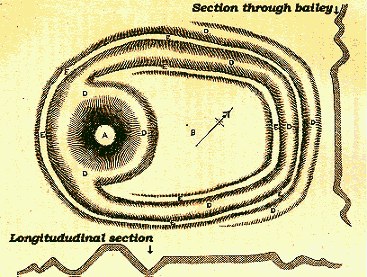 |
Hendomen 3
The occupation of Hendomen
|
|
In 1960 excavations were started
at the motte by professional archaeologists; work proceeded for
some 30 years, making it the longest on-going dig in the country.
It was carried out by Messrs. Philip Barker and Robert Higham
and their team, largely in the summer months. It ended in the
early 1990’s due to lack of funding and much work remains
to be done. |
|
19th century plan of Hendomen from
the Montgomeryshire Collections
By kind permission of the Powysland
Club
|

A - The motte
B - The bailey
D - Ditches
E - Banks |
|
The occupancy of the motte at Hendomen by the
Montgomery family was quite short, perhaps thirty years or so.
As stated earlier, there were a number of mottes between this
site and Shrewsbury at which latter place Roger would probably
have spent most of his time. He was engaged in the building of
the Abbey of St Peter and St Paul, of which original structure
little remains today - only the pulpit which stands in the former
refectory. He controlled a very large part of present day Shropshire.
Following his death in July 1094, he was buried in the Abbey
between the two altars, but following alterations to the building
his tomb was moved to the Nave where today, a small effigy [damaged]
can be seen. He had taken the habit, it said, only three days
before his death. |
|
|
The following year, 1095, the motte was in the
hands of the son. Hugh was attacked by the Welsh and a massacre
of the garrison took place. Hugh was succeeded by another son,
Roger of Belleme, but he took part in a revolt against King Henry
I and paid dearly for it. His lands in England and the Welsh
Marches were taken from him and he was compelled to return to
France where he was kept prisoner from 1102 until his death.
This effectively was the end of the Montgomerys at Hendomen.
From this date the motte was held by the
de Boulers until 1207, but the land was a mere fraction of Rogers’
original holding, probably just that in the immediate vicinity.
After the demise of the de Boulers the land reverted to the crown. |
| |
There are 7 pages on
the norman origins of Hendomen. Use the box links below to view
the other pages |
 |
       |
 |
 |

